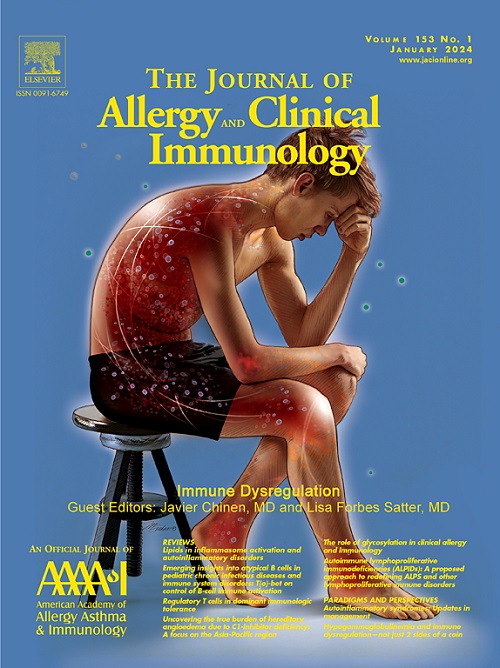Clinical, immunologic, and genetic characteristics of 148 patients with natural killer cell deficiency
IF 11.4
1区 医学
Q1 ALLERGY
引用次数: 0
Abstract
Background
Natural killer (NK) cell deficiency (NKD) is an immunodeficiency phenotype in which abnormality of NK cells is the major clinically relevant immune defect.
Objective
We sought to define the clinical, immunologic, and genetic characteristics of patients with NKD to aid in the understanding of these individuals and this cell type and guide future research and clinical practice.
Methods
During 2006-2022, 168 individuals with a suspected diagnosis of NKD were enrolled, with comprehensive clinical, immunologic, and genetic data collected and analyzed. Research exome sequencing was performed to identify both known and novel genetic associations.
Results
NK cell abnormalities consistent with NKD were confirmed in 148 participants. Most presented during childhood (median age 13 years, range 0-76 years), though 34% were adults. All tested individuals exhibited reduced NK cell cytotoxic function; 44% also had decreased NK cell numbers and/or mature NK cells. Herpesvirus and/or papillomavirus infections were observed in 71%, malignancies were observed in 7%, and a 5% case-fatality rate was noted. Among the 99 participants who underwent research exome sequencing, 29% were considered solved for a likely contributing variant allele, with 52% of these cases involving known genes and 48% involving novel genes.
Conclusions
NKD is a phenotypic immunodeficiency associated with increased susceptibility to certain viral infections and cancer with multiple genetic etiologies, revealing key biological pathways for NK cell development and function. This research underscores the role of NK cells in human immune defenses and helps advance the identification of at-risk populations, precise genetic diagnoses, and informed clinical management for patients with NKD.
148例NK细胞缺乏症患者的临床、免疫学和遗传学特征分析。
背景:自然杀伤(NK)细胞缺陷(NKD)是一种免疫缺陷表型,其中NK细胞异常是主要的临床相关免疫缺陷。目的:我们试图定义NKD患者的临床、免疫学和遗传学特征,以帮助理解这些个体和这种细胞类型,并指导未来的研究和临床实践。方法:2006-2022年,168例疑似NKD患者入组,收集并分析全面的临床、免疫学和遗传学资料。研究外显子组测序进行确定已知的和新的遗传关联。结果:148例患者证实NK细胞异常符合NKD。多数出现在儿童时期(中位年龄13岁,范围0-76岁),但34%为成年人。所有被试个体均表现出NK细胞毒性功能降低;44%的患者NK细胞数量和/或成熟NK细胞也减少。疱疹病毒和/或乳头瘤病毒感染占71%,恶性肿瘤占7%,病死率为5%。在99名接受研究外显子组测序的个体中,29%被认为解决了可能的变异等位基因,其中52%涉及已知基因,48%涉及新基因。结论:NKD是一种表型免疫缺陷,与某些病毒感染和癌症的易感性增加有关,具有多种遗传病因,揭示了NK细胞发育和功能的关键生物学途径。这项研究强调了NK细胞在人类免疫防御中的作用,并有助于促进高危人群的识别,精确的遗传诊断,并为NKD患者提供知情的临床管理。
本文章由计算机程序翻译,如有差异,请以英文原文为准。
求助全文
约1分钟内获得全文
求助全文
来源期刊
CiteScore
25.90
自引率
7.70%
发文量
1302
审稿时长
38 days
期刊介绍:
The Journal of Allergy and Clinical Immunology is a prestigious publication that features groundbreaking research in the fields of Allergy, Asthma, and Immunology. This influential journal publishes high-impact research papers that explore various topics, including asthma, food allergy, allergic rhinitis, atopic dermatitis, primary immune deficiencies, occupational and environmental allergy, and other allergic and immunologic diseases. The articles not only report on clinical trials and mechanistic studies but also provide insights into novel therapies, underlying mechanisms, and important discoveries that contribute to our understanding of these diseases. By sharing this valuable information, the journal aims to enhance the diagnosis and management of patients in the future.

 求助内容:
求助内容: 应助结果提醒方式:
应助结果提醒方式:


